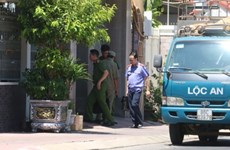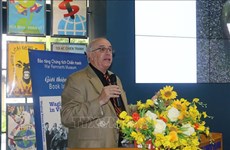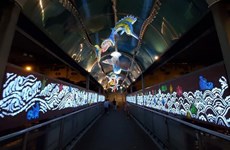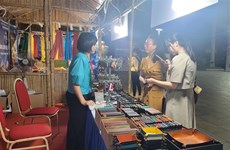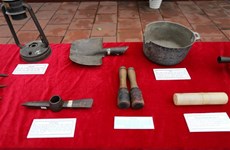Detoxification – Hope for AO victims
The establishment of a detoxification centre brings hope in a brighter future
for AO victims.
Vu Ngoc Hai used to fight at B3 battlefield in the Central Highlands
province of Kon Tum from 1968 to 1974. By the end of the war, he
returned home in the hope for a peaceful life. It turned out he had to
face another fight, which seemed to never come to an end. That is the
silent combat against diseases, the after-effects of the Agent Orange
(AO)/dioxin which Hai was exposed to during the war.
“My entire life was spent in hospital. Every few days, I got pain in my bones and joints together with symptoms of influenza like fever. I went to all hospitals from those at district and provincial levels to central hospital, but to no avail. The doctors found nothing,” Hai recalled the miserable days living with the illness.
Born in 1945 in Nam Ha commune, Tien Hai district, the northern province of Thai Binh, Hai is only one among millions of victims of the largest chemical war in the history of humankind. Between 1961 and 1971, US troops sprayed nearly 80 million litres of herbicides, including Agent Orange which had a dioxin content of up to 61 percent, on forests across southern Vietnam , with the aim to wipe out the shelters of Vietnamese liberation soldiers.
Although the war has been over for more than half a century, it still inflicts pain on victims of dioxin, the most toxic chemical that humankind have ever known. The chemical causes long-term medical and biological impacts on the health of not only Vietnamese war veterans but also their children and grandchildren. Therefore, the establishment of the Thai Binh Detoxification Centre brought hope in a brighter future for AO victims.
“Two years ago, right after learning of the toxic purifying programme implemented by the Thai Binh Detoxification Centre, I registered and luckily, got the chance to participate in the second detox drive of the centre. After nearly one month of treatment, my health improved significantly,” Hai beamed.
He said that after receiving treatment, he no longer suffers from chronic fever and other influenza symptoms. The pain in his bones and joints has also eased significantly. He eats and sleeps better, and even put on weight. Now in good health, Hai joined in Nam Ha commune’s Association for Victims of Agent Orange to help other comrades in the same boat.
Established in late 2010, the Thai Binh Detoxification Centre is the first facility in Vietnam to conduct dioxin detoxification in human, under the support of the Association for Better Living and Education ( ABLE ). The centre has so far carried out 27 detox rounds (each lasts 20-25 days), benefiting more than 700 AO victims inside and outside the province.
Based on Hubbard method, which was successfully applied for victims of the 1986 Chernobyl nuclear catastrophe in Ukraine , the treatment aims at removing toxic substances out of adipose tissues through sweat glands.
“The Hubbard method is simple and easy to do, but brings high effects if patients follow closely the set process,” said Nguyen Duc Hanh, President of the Thai Binh provincial Association for Victims of Agent Orange/dioxin.
According to Hanh, the process includes five steps. Before being detoxified, patients have to take medical check-ups. Those suffering from either liver or gall diseases, or having anaemia or contagious diseases cannot undergo this treatment.
Then, the patients will be given high doses of vitamins, mainly Niacin (also known as vitamin B3), together with doing exercises and taking steam-baths to discharge toxic substances out of the body.
They also have to take oil containing compounds that help prevent the re-absorption of dioxin as well vitamins supplements to compensate for the loss from sweat discharge.
The centre’s director Nguyen Kim Nhat said that this method is absolutely safe and highly effective. He said most patients see their health improve, while some diseases and symptoms such as skin disease, allergy, insomnia and dizziness show a recovery rate of up to 80 - 100 percent.
However, Nhat’s biggest concern is that with five sauna rooms, the centre can only give detoxification for 40-50 people at a round, while Thai Binh province alone has tens of thousands of AO victims. This means that it will take several decades to conduct detoxification for all victims of the province, not to mention millions of others nationwide.
“I hope the provincial association receives more assistance from benefactors both at home and abroad to expand the centre,” Nhat said. He added that in late June, the centre opened a training course in detox technique for health workers from some localities in the region.
The war has passed, but its severe aftermaths remain. Therefore, it is extremely necessary for the society to join hands to multiply the model of the Thai Binh Detoxification Centre to other areas across Vietnam, bringing hope to more victims of dioxin.-VNA
Previous: AO victims refuse to surrender to fate
AO victims not alone in fight for justice
Next: A So – new life sprouts from death
“My entire life was spent in hospital. Every few days, I got pain in my bones and joints together with symptoms of influenza like fever. I went to all hospitals from those at district and provincial levels to central hospital, but to no avail. The doctors found nothing,” Hai recalled the miserable days living with the illness.
Born in 1945 in Nam Ha commune, Tien Hai district, the northern province of Thai Binh, Hai is only one among millions of victims of the largest chemical war in the history of humankind. Between 1961 and 1971, US troops sprayed nearly 80 million litres of herbicides, including Agent Orange which had a dioxin content of up to 61 percent, on forests across southern Vietnam , with the aim to wipe out the shelters of Vietnamese liberation soldiers.
Although the war has been over for more than half a century, it still inflicts pain on victims of dioxin, the most toxic chemical that humankind have ever known. The chemical causes long-term medical and biological impacts on the health of not only Vietnamese war veterans but also their children and grandchildren. Therefore, the establishment of the Thai Binh Detoxification Centre brought hope in a brighter future for AO victims.
“Two years ago, right after learning of the toxic purifying programme implemented by the Thai Binh Detoxification Centre, I registered and luckily, got the chance to participate in the second detox drive of the centre. After nearly one month of treatment, my health improved significantly,” Hai beamed.
He said that after receiving treatment, he no longer suffers from chronic fever and other influenza symptoms. The pain in his bones and joints has also eased significantly. He eats and sleeps better, and even put on weight. Now in good health, Hai joined in Nam Ha commune’s Association for Victims of Agent Orange to help other comrades in the same boat.
Established in late 2010, the Thai Binh Detoxification Centre is the first facility in Vietnam to conduct dioxin detoxification in human, under the support of the Association for Better Living and Education ( ABLE ). The centre has so far carried out 27 detox rounds (each lasts 20-25 days), benefiting more than 700 AO victims inside and outside the province.
Based on Hubbard method, which was successfully applied for victims of the 1986 Chernobyl nuclear catastrophe in Ukraine , the treatment aims at removing toxic substances out of adipose tissues through sweat glands.
“The Hubbard method is simple and easy to do, but brings high effects if patients follow closely the set process,” said Nguyen Duc Hanh, President of the Thai Binh provincial Association for Victims of Agent Orange/dioxin.
According to Hanh, the process includes five steps. Before being detoxified, patients have to take medical check-ups. Those suffering from either liver or gall diseases, or having anaemia or contagious diseases cannot undergo this treatment.
Then, the patients will be given high doses of vitamins, mainly Niacin (also known as vitamin B3), together with doing exercises and taking steam-baths to discharge toxic substances out of the body.
They also have to take oil containing compounds that help prevent the re-absorption of dioxin as well vitamins supplements to compensate for the loss from sweat discharge.
The centre’s director Nguyen Kim Nhat said that this method is absolutely safe and highly effective. He said most patients see their health improve, while some diseases and symptoms such as skin disease, allergy, insomnia and dizziness show a recovery rate of up to 80 - 100 percent.
However, Nhat’s biggest concern is that with five sauna rooms, the centre can only give detoxification for 40-50 people at a round, while Thai Binh province alone has tens of thousands of AO victims. This means that it will take several decades to conduct detoxification for all victims of the province, not to mention millions of others nationwide.
“I hope the provincial association receives more assistance from benefactors both at home and abroad to expand the centre,” Nhat said. He added that in late June, the centre opened a training course in detox technique for health workers from some localities in the region.
The war has passed, but its severe aftermaths remain. Therefore, it is extremely necessary for the society to join hands to multiply the model of the Thai Binh Detoxification Centre to other areas across Vietnam, bringing hope to more victims of dioxin.-VNA
Previous: AO victims refuse to surrender to fate
AO victims not alone in fight for justice
Next: A So – new life sprouts from death









